英语简单句的五种基本句型ppt课件
合集下载
英语简单句的五种基本句型(共35张PPT)

5.主语+及物动词+从句 (做宾语) He claimed that he saw the accident. I suggested (that) we (should) leave early. Do you see why I did it? She asked if she might call and see me. I’ll do what I can. I don’t remember when that happened.
5. 定语 ( Attributive )
常指修饰名词的词或短语。 常由形容词、形容词性物主代词、名词、数词、副词、 介词短语、动词不定式或分词短语等充当。 例如: 1. The black sweater is mine. 2. We have eight classes every day. 3. The coffee cup on the table is mine.
四 主语+系动词+表语
1.感官类:feel ,look, sound, taste, smell. 2.变化类:grow, become, turn, get, go 3.其他类:come true, fall ill , stay calm,
keep fit, remain seated, stand still seem sad, appear rich, prove useful
名师课件免费课件下载优秀公开课课 件英语 简单句 的五种 基本句 型(共3 5张PPT )
名师课件免费课件下载优秀公开课课 件英语 简单句 的五种 基本句 型(共3 5张PPT )
五.主语+及物动词+宾语+宾补
1.主语+及物动词+宾语+形容词 I thought her so nice and sincere. They didn’t believe such a thing possible. You must make the classroom clean.
初中英语简单句的5种基本类型 PPT课件 图文

词
助动词 辅助动词
情态动词
be (am is are was were) / seem / keep 是/好象(似乎)是/保持 look / feel / taste / smell / sound 看/感觉/尝/闻/听起来(上去) become / turn / get / grow 变得 不及物动词 laugh / smlie / look / listen
help sb. (to) do sth.
hope和welcome 比较特殊--我们可以说: I hope to visit your school. I hope that you can visit our school. I wish you to visit our school. Welcome to visit our school. You are welcome to visit our school. Welcome to our school. 但不可以说:I hope / welcome you to visit our school.
He told me to clean my room.
I saw her dancing.
Our teacher asks us to read English every day.
及物 动词
主谓宾宾补结构(SVOC) =主语+谓语+宾语+宾语的补足语
可以用于这种句式的动词主要有 let / make sb. do sth.
He ‖ gave me a good book.
(__语) (__词) (__语) (__语) (__语) (__词) (__语) (__语)
<4>______式 He ‖ asked me to help him. He ‖ made me happy.
(完整版)简单句五大基本句型课件(共36张)
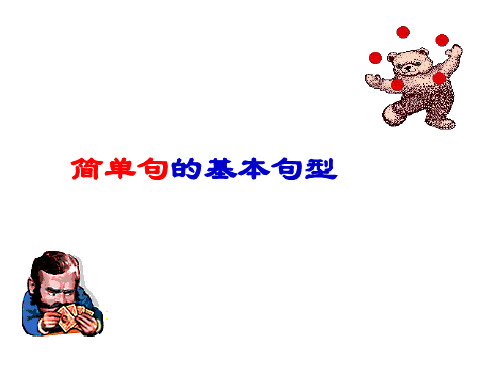
get smaller; grow older; become stronger; turn yellow; go bad; come true
3.表示状态保持的动词: stay healthy; keep warm; remain保持 be (am,is.are,was,were)是 ;seem似乎
英语中千变万化的句子归根结底都是由简单句的五 种基本句型组合、扩展、变化而来的,只要把这些基 本句型弄清楚,你就会游刃有余了
→1. S + V 主语+谓语 主谓结构
Vi 不及物动词
1.A golden eagle is flying. 后面没有宾语 2.A crane eats fish.
3.A Swan has
try /want/hope/plan/agree/choose/decide 这就是我们常见的 动词+ to do 句型 动词 + doing sth:mind/finish/practise 这就是我们常见的 动词+ doing 句型 动词 + 宾语从句: think/believe/ be sure/be afraid /say/
注意: 1 现在进行时的谓语与主系表结构有区别:
关键要看be动词后接的是实义动词ing形式还是表语(形名介)
David
a zookeeper
We call the man ‘David’.
S V DO
OC(宾补) Object
I make him angry. Complement
S
V DO OC
Predicative
系动词
表语
必须是这三类专门的词,而且必须表达这个特殊 的含义时才是系动词。 常见的连系动词 1.表示感觉的动词5个---翻译为 …起来 feel感到 excited; smell good; taste delicious;
3.表示状态保持的动词: stay healthy; keep warm; remain保持 be (am,is.are,was,were)是 ;seem似乎
英语中千变万化的句子归根结底都是由简单句的五 种基本句型组合、扩展、变化而来的,只要把这些基 本句型弄清楚,你就会游刃有余了
→1. S + V 主语+谓语 主谓结构
Vi 不及物动词
1.A golden eagle is flying. 后面没有宾语 2.A crane eats fish.
3.A Swan has
try /want/hope/plan/agree/choose/decide 这就是我们常见的 动词+ to do 句型 动词 + doing sth:mind/finish/practise 这就是我们常见的 动词+ doing 句型 动词 + 宾语从句: think/believe/ be sure/be afraid /say/
注意: 1 现在进行时的谓语与主系表结构有区别:
关键要看be动词后接的是实义动词ing形式还是表语(形名介)
David
a zookeeper
We call the man ‘David’.
S V DO
OC(宾补) Object
I make him angry. Complement
S
V DO OC
Predicative
系动词
表语
必须是这三类专门的词,而且必须表达这个特殊 的含义时才是系动词。 常见的连系动词 1.表示感觉的动词5个---翻译为 …起来 feel感到 excited; smell good; taste delicious;
5种简单基本句型PPT课件
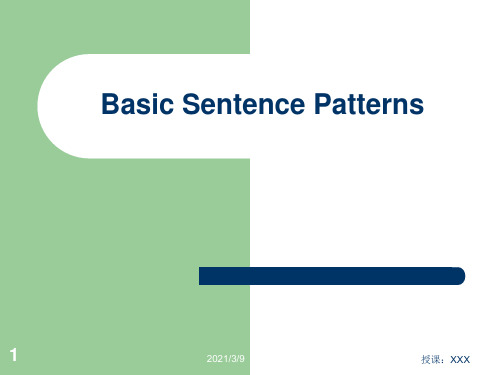
5
exclamation po2i0n21t/3(/9!).
授课:XXX
Sample Sentences
subject
1. The boy 2. The boy 3. The girl 4. The girl 5. The man 6. A thief 7. (You)
6
verb
ran. ran yelled. yelled bought took Save
11
2021/3/9
授课:XXX
Subject + Verb + Object(i) + Object(d)
Last week, my father gave me an MP4 as a birthday gift.
Last week, my father gave an MP4 to me as a birthday gift.
I found it very pleasant to be with your family.
I think it no use talking with him.
14
2021/3/9
授课:XXX
there + be + 主语 + 状语
现在有 There is/are … 过去有 There was/were… 将来有 There will be…/There is /are going to be... 现在已经有 There has/have been… 可能有 There might be... 肯定有 There must be …/There must have been... 过去一直有 There used to be … 似乎有 There seems/seem/seemed to be … 碰巧有 There happen/happens/happened to be …
简单句五大基本句型课件(共36张)
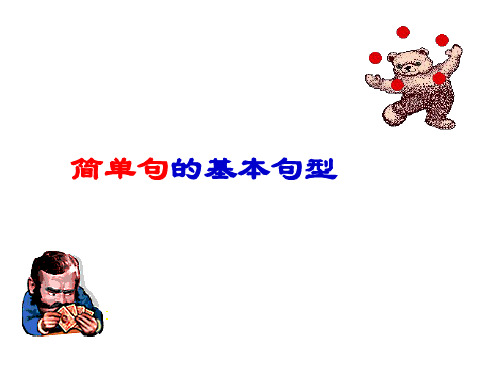
eturn/ hand 加for: buy/ choose/ draw/ make/ order/ paint/ sing/ save
双宾语结构中有两个宾语,判断标准是 可否将两个宾语顺序替换并加介词to/for
1 I feel excited. 主语+ 谓语(系动词) + 表语 2 They are watching TV. 主语+谓语(及)+宾语 3 Many boys are running. 主语+谓语(不及物) 4 He gave Tom a present. 主 +谓 + 间宾+直宾句型 5 I find it interesting. 主 +谓 + 宾+宾补 6 Music sounds beautiful.主语+ 谓语(系动词) + 表语 7 I am a student. 主语+ 谓语(系动词) + 表语 8 She bought a pen for me主. +谓 + 间宾+直宾句型
英语中千变万化的句子归根结底都是由简单句的五 种基本句型组合、扩展、变化而来的,只要把这些基 本句型弄清楚,你就会游刃有余了
→1. S + V 主语+谓语 主谓结构
Vi 不及物动词
1.A golden eagle is flying. 后面没有宾语 2.A crane eats fish.
3.A Swan has
know/find
→1. S + V(lv) + P 主语+ 谓语(系动词) + 表语
be (am is are was were) / seem / keep /…是/好象(似 乎)是/保持
双宾语结构中有两个宾语,判断标准是 可否将两个宾语顺序替换并加介词to/for
1 I feel excited. 主语+ 谓语(系动词) + 表语 2 They are watching TV. 主语+谓语(及)+宾语 3 Many boys are running. 主语+谓语(不及物) 4 He gave Tom a present. 主 +谓 + 间宾+直宾句型 5 I find it interesting. 主 +谓 + 宾+宾补 6 Music sounds beautiful.主语+ 谓语(系动词) + 表语 7 I am a student. 主语+ 谓语(系动词) + 表语 8 She bought a pen for me主. +谓 + 间宾+直宾句型
英语中千变万化的句子归根结底都是由简单句的五 种基本句型组合、扩展、变化而来的,只要把这些基 本句型弄清楚,你就会游刃有余了
→1. S + V 主语+谓语 主谓结构
Vi 不及物动词
1.A golden eagle is flying. 后面没有宾语 2.A crane eats fish.
3.A Swan has
know/find
→1. S + V(lv) + P 主语+ 谓语(系动词) + 表语
be (am is are was were) / seem / keep /…是/好象(似 乎)是/保持
简单句五大基本句型课件(共36张)

句型三:主语 + 谓语 + 双宾语
总结词
这种句型在主谓宾的基础上增加了一个间接宾语和一个直接宾语。
详细描述
双宾语中,直接宾语是动作的直接承受者,间接宾语则表示动作对某人产生的影响或结果。例如,“She gave me a book”中,“She”是主语,“gave”是谓语,“me”是间接宾语,“a book”是直接宾语,表示主语 执行了“给予”的动作,间接宾语是动作的受益者,直接宾语是动作的对象。
简单句五大基本句型课件
CATALOGUE
目 录
• 简单句五大基本句型概述 • 简单句五大基本句型的用法 • 简单句五大基本句型的练习 • 简单句五大基本句型的注意事项
01
CATALOGUE
简单句五大基本句型概述
句型一:主语 + 谓语
总结词
主语+谓语是最简单的句子结构,表示主语执行的动作。
详细描述
冗余或重复
句子中不应该有多余 或重复的信息,这会 使句子显得啰嗦。
如何避免使用简单句五大基本句型的常见错误
学习并掌握五大基本句型
了解并掌握简单句的五大基本句型, 包括主谓、主谓宾、主谓双宾、主谓 宾宾补和主系表结构。
注意时态和语态
在写作时,要注意动词的时态和语态 ,确保与句子的语境相符。
检查主谓一致
总结词
主谓双宾结构,有两个宾 语,通常一个指人,一个 指物。
详细描述
例如,“She gave me a book.”(她给了我一本书 。)
练习建议
尝试使用此句型描述人与 人之间的互动,如“He taught me how to swim.”(他教我如何游泳 。)
句型四
总结词
主谓宾补结构,有一个宾语和一 个补足语,补足语补充说明宾语
英语简单句的五个基本句型精品PPT课件

4.表持续的系动词。如___re_m__a_in____,____k_e_e_p___, ___s_t_a_y____,stand,rest,lie,hold等。
5.可带名词作表语的系动词。如be,__b_e_c_o_m__e_, ____s_o_u_n_d__,prove,remain,turn(该词后接的单数名 词前多不用冠词。如:He turned teacher.)等。
my heart into my study.我失败的原因在于我没 有全心全意学习。(表语从句)
句型1:主语+系动词+表语 1.我今天身体不太好。 I am not quite well today./ I feel bad today.
2.我希望你的梦想能成真。 I hope that your dream can come true. My wish is that your dream can come true.
His joke made all of us laugh. 注:其他各种句子都可由这些基本句型扩展、 变化或省略而构成。
基本句型一:主语+系动词+表语
该句型中,谓语动词不能表达一个完整的意思,必须加上 一个表明主语身份或状态的表语构成复合谓语,才能表 达完整的意思。这类动词叫做连系动词。
一)系动词有:
二):作表语的有名词、形容词、介词短语等。如:
1. He is a boy.他是一个男孩。( 名词 ) 2. The book is hers.这本书是他的。(名词性物主
代词) 3. He is tall.他个子高。( 形容词 ) 4. John is in good health.他身体健康。(介词短语) 5. We were excited at the good news.听到这个
5.可带名词作表语的系动词。如be,__b_e_c_o_m__e_, ____s_o_u_n_d__,prove,remain,turn(该词后接的单数名 词前多不用冠词。如:He turned teacher.)等。
my heart into my study.我失败的原因在于我没 有全心全意学习。(表语从句)
句型1:主语+系动词+表语 1.我今天身体不太好。 I am not quite well today./ I feel bad today.
2.我希望你的梦想能成真。 I hope that your dream can come true. My wish is that your dream can come true.
His joke made all of us laugh. 注:其他各种句子都可由这些基本句型扩展、 变化或省略而构成。
基本句型一:主语+系动词+表语
该句型中,谓语动词不能表达一个完整的意思,必须加上 一个表明主语身份或状态的表语构成复合谓语,才能表 达完整的意思。这类动词叫做连系动词。
一)系动词有:
二):作表语的有名词、形容词、介词短语等。如:
1. He is a boy.他是一个男孩。( 名词 ) 2. The book is hers.这本书是他的。(名词性物主
代词) 3. He is tall.他个子高。( 形容词 ) 4. John is in good health.他身体健康。(介词短语) 5. We were excited at the good news.听到这个
英语句子成分及简单句的五种基本句型ppt课件

b. 介词短语 We’re going to spend the holiday at the seaside.
c. 分词短语 Not knowing what to do I decided to give up.
27
d. 动词不定式短语 His mother often comes to see him.
1. S+V+P 主+系+表
This is an English dictionary. The dinner smells good. The well has gone dry. He is growing tall and strong.
34
英语co五nt种en基t 本句型
2. S+V 分的功能
四、 表语:
表语主要用于表述主语的特征,状态,身份 等。它位于_连__系__动__词__后,构成系表结构。
17
各个成分的功能
表Ad示d状yo态ur title
系动词
be
A一dd直yo保ur持title
keep, remain,stay
看A起dd来yo,ur似tit乎le
seem, appear
The sun was shinning.
We all breathe, eat and drink.
His parents have worked in the factory for more than 10 years.
35
英语五co种nt基en本t 句型
3. S+V+O 主+谓(及物动词)+宾
感Ad官d系yo动ur词title look, sound, smell , taste, feel
become, turn ,fall, grow, get,
c. 分词短语 Not knowing what to do I decided to give up.
27
d. 动词不定式短语 His mother often comes to see him.
1. S+V+P 主+系+表
This is an English dictionary. The dinner smells good. The well has gone dry. He is growing tall and strong.
34
英语co五nt种en基t 本句型
2. S+V 分的功能
四、 表语:
表语主要用于表述主语的特征,状态,身份 等。它位于_连__系__动__词__后,构成系表结构。
17
各个成分的功能
表Ad示d状yo态ur title
系动词
be
A一dd直yo保ur持title
keep, remain,stay
看A起dd来yo,ur似tit乎le
seem, appear
The sun was shinning.
We all breathe, eat and drink.
His parents have worked in the factory for more than 10 years.
35
英语五co种nt基en本t 句型
3. S+V+O 主+谓(及物动词)+宾
感Ad官d系yo动ur词title look, sound, smell , taste, feel
become, turn ,fall, grow, get,
简单句的五大基本句型PPT课件
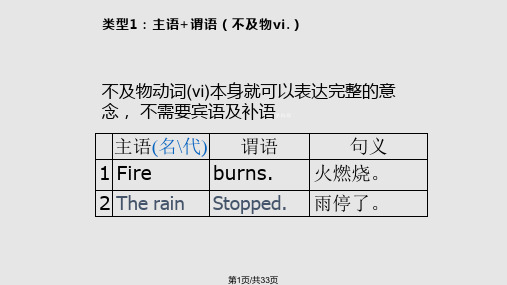
宾语与现在分词之间是主动关系; 过去分词为宾语补足语时,宾
第17页/共33页
句子成分口诀
• 主谓宾、定状补, • 主干枝叶分清楚, • 主要成分主谓宾, • 附加成分定状补, • 定语必居主宾前, • 谓前为状谓后补。 第18页/共33页
【巩固提高练习】 1.The train is coming
第4页/共33页
1.2两个例句中这类动词有attempt, help, want, agree, dare, decide, need, desire, expect , intend, learn, offer, promise…等
主语
谓语
1I
promised
2 They decided
宾语(不定式) to help them. not to go.
(1)并列连词的选用。 (2)并列连词与从属连词的区别。
第23页/共33页
➢ 典型例题解析
【例1】 John likes walking in the open air, A . [2001 吉林]
A.so does Tom
B.also does Tom
C.tom likes also
D.so Tom does
She is heard to sing next door .
第16页/共33页
• I saw him running off. • I smelt something burning. • You must get your hair cut. • She had a new cap made. 提示:现在分词为宾语补足语时,
主语
谓语ted
playing chess. changing it
第17页/共33页
句子成分口诀
• 主谓宾、定状补, • 主干枝叶分清楚, • 主要成分主谓宾, • 附加成分定状补, • 定语必居主宾前, • 谓前为状谓后补。 第18页/共33页
【巩固提高练习】 1.The train is coming
第4页/共33页
1.2两个例句中这类动词有attempt, help, want, agree, dare, decide, need, desire, expect , intend, learn, offer, promise…等
主语
谓语
1I
promised
2 They decided
宾语(不定式) to help them. not to go.
(1)并列连词的选用。 (2)并列连词与从属连词的区别。
第23页/共33页
➢ 典型例题解析
【例1】 John likes walking in the open air, A . [2001 吉林]
A.so does Tom
B.also does Tom
C.tom likes also
D.so Tom does
She is heard to sing next door .
第16页/共33页
• I saw him running off. • I smelt something burning. • You must get your hair cut. • She had a new cap made. 提示:现在分词为宾语补足语时,
主语
谓语ted
playing chess. changing it
英语简单句5种基本类型 公开课ppt课件

3.表示状态变化的有: become, get, grow, turn, go, run, fall;
4.表状态延续的有:remain, k. eep, stay;
★系动词的用法: (注意三点)
+____a_d_j_. ____作表语; 无 __宾__语______; 无 __被__动__语__态__;
book to me.
1. He came into the room.
2. The music sounds wonderful.
3. I have seen the film.
4. He gave a pen to me.
5. My father bought a book for me .
.
Exercises : 翻译下列句子并分析句子结构:
.
Let's have a try!
.
1. 今年刘老师教我们数学。 (teach) Mr. Liu teaches us maths this year. 2.昨晚她给我们讲了一个有趣的故事。(tell) She told us an interesting story last night. 3. 你能把那本字典递给我吗? (pass) Could you pass me the dictionary?
(1)The teacher was speaking.
2.每天八点开始上课。(begin) Classes begin at eight every day.
.
1、Translation
1.明天她会过来。(come) She will come tomorrow. 2.五年前我住在武汉。 (live) I lived in Wuhan five years ago.
4.表状态延续的有:remain, k. eep, stay;
★系动词的用法: (注意三点)
+____a_d_j_. ____作表语; 无 __宾__语______; 无 __被__动__语__态__;
book to me.
1. He came into the room.
2. The music sounds wonderful.
3. I have seen the film.
4. He gave a pen to me.
5. My father bought a book for me .
.
Exercises : 翻译下列句子并分析句子结构:
.
Let's have a try!
.
1. 今年刘老师教我们数学。 (teach) Mr. Liu teaches us maths this year. 2.昨晚她给我们讲了一个有趣的故事。(tell) She told us an interesting story last night. 3. 你能把那本字典递给我吗? (pass) Could you pass me the dictionary?
(1)The teacher was speaking.
2.每天八点开始上课。(begin) Classes begin at eight every day.
.
1、Translation
1.明天她会过来。(come) She will come tomorrow. 2.五年前我住在武汉。 (live) I lived in Wuhan five years ago.
2023年中考英语复习简单句课件(共28张PPT)

• hong kong is not very cold in winter冬天,香港不太冷
• 五种基本句型
• 1.主语+谓语 • I listen carefully. 2.主语+谓语+宾语 I kicked the ball. • 3.主语+系动词+表语 • The apple tastes good. • 4.主语+谓语+直接宾语+间接宾语 • She passed me some salt. • 5.主语+谓语+宾语+宾补 • My mother wants me to drink the milk.
• 三、There be 句型(也叫存现句) • 1“There is/are+某物/某人+某地/某时”结构表示“某地或某时有某物或 • 某人”。 • 如:There are two glasses of water on the table桌子上有两杯水。
• There is a good movie on TV tonight.今天晚上在电视上有一部好电影
let her not cry.
• There are more than fifty classes in yourschool,__________?
• There are few people in the classroom, _________?
• (3)陈述部分是祈使句,反意疑问部分用 will you。 • Take care of your children,will you? • Open the door,_____________?
• He seldom goes to the cinema, does he?
• 五种基本句型
• 1.主语+谓语 • I listen carefully. 2.主语+谓语+宾语 I kicked the ball. • 3.主语+系动词+表语 • The apple tastes good. • 4.主语+谓语+直接宾语+间接宾语 • She passed me some salt. • 5.主语+谓语+宾语+宾补 • My mother wants me to drink the milk.
• 三、There be 句型(也叫存现句) • 1“There is/are+某物/某人+某地/某时”结构表示“某地或某时有某物或 • 某人”。 • 如:There are two glasses of water on the table桌子上有两杯水。
• There is a good movie on TV tonight.今天晚上在电视上有一部好电影
let her not cry.
• There are more than fifty classes in yourschool,__________?
• There are few people in the classroom, _________?
• (3)陈述部分是祈使句,反意疑问部分用 will you。 • Take care of your children,will you? • Open the door,_____________?
• He seldom goes to the cinema, does he?
英语简单句五种基本句型课件ppt
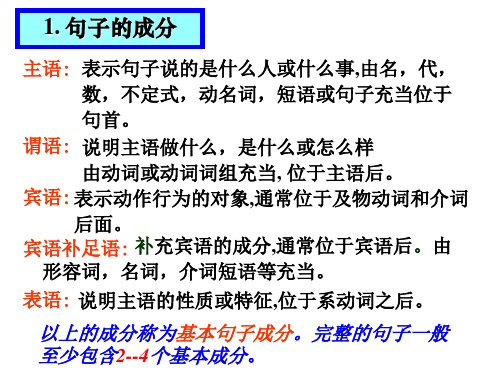
用to侧重指动作的方向,表示朝着,向着,对着某人。 用for 侧重指动作的受益者,表示为了某人,替某人。 常跟双宾语的动词有: (需借助 to的)bring, give, lend, hand, offer, pass, pay,
promise, return, send, show, teach, tell, write, ask等 (需借助for的)buy, call, cook, choose, draw, find, get,
若要先说出直接宾语,后说间接宾语,则要借助与 介词to 或for。
He bought me a beautiful skirt.
He bought a beautiful skirt for me.
从使用情况来看,闭胸式的使用比较 广泛。 敞开式 盾构之 中有挤 压式盾 构、全 部敞开 式盾构 ,但在 近些年 的城市 地下工 程施工 中已很 少使用 ,在此 不再说 明。
make, order, sing等。
从使用情况来看,闭胸式的使用比较 广泛。 敞开式 盾构之 中有挤 压式盾 构、全 部敞开 式盾构 ,但在 近些年 的城市 地下工 程施工 中已很 少使用 ,在此 不再说 明。
基本句型 五
S +V +O +C(主+谓+宾+宾补)
此句型中谓语动词除了跟一个宾语外,还需跟一 个补充成分来不足宾语,才能使意思完整。
从使用情况来看,闭胸式的使用比较 广泛。 敞开式 盾构之 中有挤 压式盾 构、全 部敞开 式盾构 ,但在 近些年 的城市 地下工 程施工 中已很 少使用 ,在此 不再说 明。
注意:用 it 做形式宾语,而将真正的宾语放到 宾语补足语的后面,是英语常用句型。
即 主语 + 谓语 + it + 宾补 + 真正宾语。如, I found it very pleasant to be with your family. 常用于此句型的动词有:think, believe, consider, suppose, find, feel, make
promise, return, send, show, teach, tell, write, ask等 (需借助for的)buy, call, cook, choose, draw, find, get,
若要先说出直接宾语,后说间接宾语,则要借助与 介词to 或for。
He bought me a beautiful skirt.
He bought a beautiful skirt for me.
从使用情况来看,闭胸式的使用比较 广泛。 敞开式 盾构之 中有挤 压式盾 构、全 部敞开 式盾构 ,但在 近些年 的城市 地下工 程施工 中已很 少使用 ,在此 不再说 明。
make, order, sing等。
从使用情况来看,闭胸式的使用比较 广泛。 敞开式 盾构之 中有挤 压式盾 构、全 部敞开 式盾构 ,但在 近些年 的城市 地下工 程施工 中已很 少使用 ,在此 不再说 明。
基本句型 五
S +V +O +C(主+谓+宾+宾补)
此句型中谓语动词除了跟一个宾语外,还需跟一 个补充成分来不足宾语,才能使意思完整。
从使用情况来看,闭胸式的使用比较 广泛。 敞开式 盾构之 中有挤 压式盾 构、全 部敞开 式盾构 ,但在 近些年 的城市 地下工 程施工 中已很 少使用 ,在此 不再说 明。
注意:用 it 做形式宾语,而将真正的宾语放到 宾语补足语的后面,是英语常用句型。
即 主语 + 谓语 + it + 宾补 + 真正宾语。如, I found it very pleasant to be with your family. 常用于此句型的动词有:think, believe, consider, suppose, find, feel, make
经典课件简单句五大句型主谓宾宾ppt
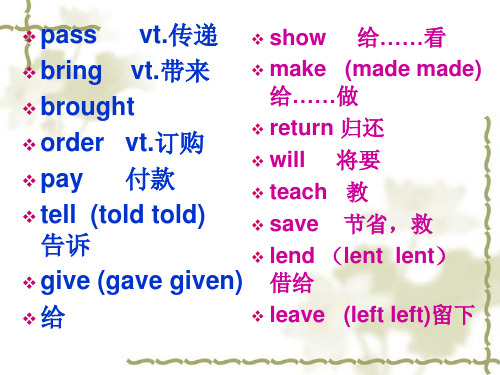
❖6.The boy sent me the message. (to)→
❖7.Dad made us a model ship.(for) →
❖8.My aunt often buys me presents. (for) →
❖9. Who will fetch me some chalk? (for)→
病原体侵入机体,消弱机体防御机能 ,破坏 机体内 环境的 相对稳 定性, 且在一 定部位 生长繁 殖,引 起不同 程度的 病理生 理过程
❖ skirt 裙子 ❖ time 时间 ❖ salt 盐 ❖ eraser 橡皮擦 ❖ message 消息 ❖ wish 祝愿 ❖ in time 及时 ❖ favor 好事 ❖ paper 纸
❖ 宾补一般由名词、形容词、副词、介词短语、 不定式或分词充当。
❖ 宾语和宾补合称复合宾语。eg. ❖ We call him(Peter). ❖ They 〈always〉keep the room(clean).
病原体侵入机体,消弱机体防御机能 ,破坏 机体内 环境的 相对稳 定性, 且在一 定部位 生长繁 殖,引 起不同 程度的 病理生 理过程
❖3)cost, kiss, keep, mean, forgive, set(第三类则不宜将所带的间接宾语
改为介词短语。 )
病原体侵入机体,消弱机体防御机能 ,破坏 机体内 环境的 相对稳 定性, 且在一 定部位 生长繁 殖,引 起不同 程度的 病理生 理过程
❖有时候,可以把直接宾语放在前面, 而把间接宾语放在后面,这时要加 介词to或者for。eg.
time.
病原体侵入机体,消弱机体防御机能 ,破坏 机体内 环境的 相对稳 定性, 且在一 定部位 生长繁 殖,引 起不同 程度的 病理生 理过程
❖7.Dad made us a model ship.(for) →
❖8.My aunt often buys me presents. (for) →
❖9. Who will fetch me some chalk? (for)→
病原体侵入机体,消弱机体防御机能 ,破坏 机体内 环境的 相对稳 定性, 且在一 定部位 生长繁 殖,引 起不同 程度的 病理生 理过程
❖ skirt 裙子 ❖ time 时间 ❖ salt 盐 ❖ eraser 橡皮擦 ❖ message 消息 ❖ wish 祝愿 ❖ in time 及时 ❖ favor 好事 ❖ paper 纸
❖ 宾补一般由名词、形容词、副词、介词短语、 不定式或分词充当。
❖ 宾语和宾补合称复合宾语。eg. ❖ We call him(Peter). ❖ They 〈always〉keep the room(clean).
病原体侵入机体,消弱机体防御机能 ,破坏 机体内 环境的 相对稳 定性, 且在一 定部位 生长繁 殖,引 起不同 程度的 病理生 理过程
❖3)cost, kiss, keep, mean, forgive, set(第三类则不宜将所带的间接宾语
改为介词短语。 )
病原体侵入机体,消弱机体防御机能 ,破坏 机体内 环境的 相对稳 定性, 且在一 定部位 生长繁 殖,引 起不同 程度的 病理生 理过程
❖有时候,可以把直接宾语放在前面, 而把间接宾语放在后面,这时要加 介词to或者for。eg.
time.
病原体侵入机体,消弱机体防御机能 ,破坏 机体内 环境的 相对稳 定性, 且在一 定部位 生长繁 殖,引 起不同 程度的 病理生 理过程
简单句五种基本句型课件(共19张PPT)

系动词可分四类:
1)be 本身没有什么意义,只起连系主语和表语的 作用,后可接动词外的任何词;
2)感官动词类 look, feel, smell, taste, sound等 +adj.
3)表示变化:get, grow, become, turn, go等
+adj.
4)表示状态延续:stay, keep, prove, remain, stand等
I
want
O her mother. a cup of tea.
练习:
1.昨晚我写了一封信。 2.今天下午我想同你谈谈。 3.这本书他读过多次了。 4.他们成功地完成了计划。 5.那位先生能流利地说三种语言。
1. I wrote a letter last night. 2. I want to talk with you this afternoon. 3. He has read this book many times.
OC
1.We keep the table clean.
2.I
saw
them getting on the bus.
3. 他让我马上回来。
He asked me to come back soon.
练习:
1.W我e c们a叫ll h她eAr Alicliec.e. 2A.ll我o们f u大s 家co都ns认id为er他ed是h诚im实h的o。nest. 3.T他he们y 把ha小ve偷s释et放th了e。thief free. 4.I 我wa要n你t y把ou真t相o t告el诉l m我e。the truth. 5 .卫Th兵e 命gu令ar我ds们o立rd即er离ed开u。s to leave at once. 6. 每E天ve早ry晨m我o们rn都in听g w到e他h大ea声r h朗im读r英ea语d。English aloud. 7.他He每h个as月h理is一h次air发cut once a month. 8.我W们e w不o会n’让t l她et在he晚r 上go外o出ut的at。night.
1)be 本身没有什么意义,只起连系主语和表语的 作用,后可接动词外的任何词;
2)感官动词类 look, feel, smell, taste, sound等 +adj.
3)表示变化:get, grow, become, turn, go等
+adj.
4)表示状态延续:stay, keep, prove, remain, stand等
I
want
O her mother. a cup of tea.
练习:
1.昨晚我写了一封信。 2.今天下午我想同你谈谈。 3.这本书他读过多次了。 4.他们成功地完成了计划。 5.那位先生能流利地说三种语言。
1. I wrote a letter last night. 2. I want to talk with you this afternoon. 3. He has read this book many times.
OC
1.We keep the table clean.
2.I
saw
them getting on the bus.
3. 他让我马上回来。
He asked me to come back soon.
练习:
1.W我e c们a叫ll h她eAr Alicliec.e. 2A.ll我o们f u大s 家co都ns认id为er他ed是h诚im实h的o。nest. 3.T他he们y 把ha小ve偷s释et放th了e。thief free. 4.I 我wa要n你t y把ou真t相o t告el诉l m我e。the truth. 5 .卫Th兵e 命gu令ar我ds们o立rd即er离ed开u。s to leave at once. 6. 每E天ve早ry晨m我o们rn都in听g w到e他h大ea声r h朗im读r英ea语d。English aloud. 7.他He每h个as月h理is一h次air发cut once a month. 8.我W们e w不o会n’让t l她et在he晚r 上go外o出ut的at。night.
英语基本句型五大句型讲解ppt课件(2024版)

此句型的句子的共同特点是: 动词虽然是及物动词,但是只跟 一个宾语还不能表达完整的意思, 必须加上一个补充成分来补足宾
语,才能使意思完整。
13
S V(及物)O(宾语) C(宾补)
1. We 2. They 3. They 4. They 5. What 6. We 7. He 8. I
keep painted call found makes saw asked saw
17
不同的动词使用的句型也不尽一样,因此 在学习动词时,应掌握动词的类型。以 get 为例:
He's getting angry. He got through the window. You'll get a surprise. He got his shoes and socks wet. He got himself into trouble. He got her a splendid present.
6.Many animals live in trees. 主+谓
21
不同的动词使用的句型也不尽一样,因此
在学习动词时,应掌握动词的类型。以 get 为例:
He's getting angry.
(S V P)
He got through the window. (S V O)
You'll get a surprise. (S V O)
15
(二)
16
1.They work hard. 2.The flower is dead. 3.Plants need water. 4.He gives me some seeds. 5.We should keep the plants in the shade. 6.Many animals live in trees.
语,才能使意思完整。
13
S V(及物)O(宾语) C(宾补)
1. We 2. They 3. They 4. They 5. What 6. We 7. He 8. I
keep painted call found makes saw asked saw
17
不同的动词使用的句型也不尽一样,因此 在学习动词时,应掌握动词的类型。以 get 为例:
He's getting angry. He got through the window. You'll get a surprise. He got his shoes and socks wet. He got himself into trouble. He got her a splendid present.
6.Many animals live in trees. 主+谓
21
不同的动词使用的句型也不尽一样,因此
在学习动词时,应掌握动词的类型。以 get 为例:
He's getting angry.
(S V P)
He got through the window. (S V O)
You'll get a surprise. (S V O)
15
(二)
16
1.They work hard. 2.The flower is dead. 3.Plants need water. 4.He gives me some seeds. 5.We should keep the plants in the shade. 6.Many animals live in trees.
- 1、下载文档前请自行甄别文档内容的完整性,平台不提供额外的编辑、内容补充、找答案等附加服务。
- 2、"仅部分预览"的文档,不可在线预览部分如存在完整性等问题,可反馈申请退款(可完整预览的文档不适用该条件!)。
- 3、如文档侵犯您的权益,请联系客服反馈,我们会尽快为您处理(人工客服工作时间:9:00-18:30)。
in the past thirty years.所发生的事情— 变化)
2
2. 谓语 ( Predicate )
说明主语“做什么” “是什么” 或 “怎么样”。 通常由动词或动词短语结合时态、语态、语气等充当。 要弄清两个概念: 及物动词:后面直接接宾语的动词; 不及物动词:后面不能直接接宾语的动词。 例如: 1. Children like playing games. 2. They were talking about a new film.
6
6. 状语 ( Adverbial )
常指修饰动词、形容词或副词的成分,修饰动词时 表示动作发生的时间、地点、目的或方式等;修饰 形容词或副词时表示它们的程度等。状语常由副词、 介词短语、动词不定式或分词短语等充当。 例如:1. The miners work very hard. 2. She often helps Mike at school. 3. Hearing the news, he couldn’t help jumping.
7
7. 宾语补足语 ( Object Complement )
常指补充说明宾语的成分,逻辑上与宾语是“主谓” 关系。常由形容词、名词、介词短语、动词不定式 或分词短语等充当。 例如: 1. She keeps the house clean every day. 2. Nobody calls me a liar. 3. We last saw him playing on the playground.
4
4. 表语 ( Predicative )
与系动词连用,一起构成谓语,说明主语的性质特征等。
常由名词、代词、形容词、数词、短语或从句等充当。
英语中常见的连系动词有: look; sound; feel; seem等
例如:
1. Her grandfather is an engineer.
2. The two countries were at war then.
3. The fact seems that he didn’t notice the
car.
5
5. 定语 ( Attributive )
常指修饰名词的词或短语。 常由形容词、形容词性物主代词、名词、数词、副词、 介词短语、动词不定式或分词短语等充当。 例如: 1. The black sweater is mine. 2. We have eight classes every day. 3. The coffee cup on the table is mine.
8
五种基本句型
1. 主语+不及物动词 Everybody smiled. 2. 主语+及物动词+宾语 He knows everything. 3. 主语+双宾动词+间接宾语+直接宾语 I showed him my passport. 4. 主语+系动词+表语 The boy looks healthy. 5. 主语+及物动词+宾语+宾语补语 What made you angry?
祈使句的主语一般都省略掉
9#43;不及物动词 The sun is rising. It will snow. Can you fly?
2.主语+不及物动词+状语 Did you sleep well? She often dreams. You go first and I will follow behind.
11
二 主语+及物动词+宾语
1.主语+及物动词+名词(代词) Do you know them? He loved ice-cream.
2. 主语+及物动词+反身代词 Now I will introduce myself. They blamed themselves for the accident.
13
5.主语+及物动词+从句 (做宾语) He claimed that he saw the accident. I suggested (that) we (should) leave early. Do you see why I did it? She asked if she might call and see me. I’ll do what I can. I don’t remember when that happened.
10
3. 主语+不及物动词+副词(构成成语动词) The engine broke down. How did the accident come about? The bomb blew up.
4.主语+不及物动词(有被动意思) Is the book selling well? Does this cloth wash well?
3
3. 宾语 ( Object )
常指及物动词或介词后面使之意思完整的词或短语。 常由名词、代词、动词不定式或doing短语等充当。 例如: 1. She has finished doing the experiment. 2. We like English and are good at it.
12
3. 主语+及物动词+不定式(做宾语) We can’t afford to pay such a price. You must try to improve. He forgot which way to go.
4.主语+及物动词+doing(做宾语) Would you mind waiting for a few minutes? I prefer standing. I propose resting for half an hour.
英语的基本句型
1
1. 主语 ( Subject )
表示句子说的是“什么人” 或 “什么事”。 通常由名词、代词、主语从句或doing短语等充当。
例如: 1. My teacher hates telling lies. (指老师这个
人) 2. Great changes have taken place in China
2
2. 谓语 ( Predicate )
说明主语“做什么” “是什么” 或 “怎么样”。 通常由动词或动词短语结合时态、语态、语气等充当。 要弄清两个概念: 及物动词:后面直接接宾语的动词; 不及物动词:后面不能直接接宾语的动词。 例如: 1. Children like playing games. 2. They were talking about a new film.
6
6. 状语 ( Adverbial )
常指修饰动词、形容词或副词的成分,修饰动词时 表示动作发生的时间、地点、目的或方式等;修饰 形容词或副词时表示它们的程度等。状语常由副词、 介词短语、动词不定式或分词短语等充当。 例如:1. The miners work very hard. 2. She often helps Mike at school. 3. Hearing the news, he couldn’t help jumping.
7
7. 宾语补足语 ( Object Complement )
常指补充说明宾语的成分,逻辑上与宾语是“主谓” 关系。常由形容词、名词、介词短语、动词不定式 或分词短语等充当。 例如: 1. She keeps the house clean every day. 2. Nobody calls me a liar. 3. We last saw him playing on the playground.
4
4. 表语 ( Predicative )
与系动词连用,一起构成谓语,说明主语的性质特征等。
常由名词、代词、形容词、数词、短语或从句等充当。
英语中常见的连系动词有: look; sound; feel; seem等
例如:
1. Her grandfather is an engineer.
2. The two countries were at war then.
3. The fact seems that he didn’t notice the
car.
5
5. 定语 ( Attributive )
常指修饰名词的词或短语。 常由形容词、形容词性物主代词、名词、数词、副词、 介词短语、动词不定式或分词短语等充当。 例如: 1. The black sweater is mine. 2. We have eight classes every day. 3. The coffee cup on the table is mine.
8
五种基本句型
1. 主语+不及物动词 Everybody smiled. 2. 主语+及物动词+宾语 He knows everything. 3. 主语+双宾动词+间接宾语+直接宾语 I showed him my passport. 4. 主语+系动词+表语 The boy looks healthy. 5. 主语+及物动词+宾语+宾语补语 What made you angry?
祈使句的主语一般都省略掉
9#43;不及物动词 The sun is rising. It will snow. Can you fly?
2.主语+不及物动词+状语 Did you sleep well? She often dreams. You go first and I will follow behind.
11
二 主语+及物动词+宾语
1.主语+及物动词+名词(代词) Do you know them? He loved ice-cream.
2. 主语+及物动词+反身代词 Now I will introduce myself. They blamed themselves for the accident.
13
5.主语+及物动词+从句 (做宾语) He claimed that he saw the accident. I suggested (that) we (should) leave early. Do you see why I did it? She asked if she might call and see me. I’ll do what I can. I don’t remember when that happened.
10
3. 主语+不及物动词+副词(构成成语动词) The engine broke down. How did the accident come about? The bomb blew up.
4.主语+不及物动词(有被动意思) Is the book selling well? Does this cloth wash well?
3
3. 宾语 ( Object )
常指及物动词或介词后面使之意思完整的词或短语。 常由名词、代词、动词不定式或doing短语等充当。 例如: 1. She has finished doing the experiment. 2. We like English and are good at it.
12
3. 主语+及物动词+不定式(做宾语) We can’t afford to pay such a price. You must try to improve. He forgot which way to go.
4.主语+及物动词+doing(做宾语) Would you mind waiting for a few minutes? I prefer standing. I propose resting for half an hour.
英语的基本句型
1
1. 主语 ( Subject )
表示句子说的是“什么人” 或 “什么事”。 通常由名词、代词、主语从句或doing短语等充当。
例如: 1. My teacher hates telling lies. (指老师这个
人) 2. Great changes have taken place in China
